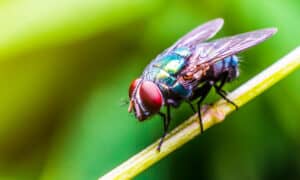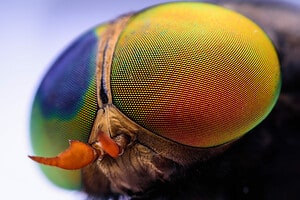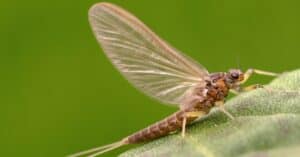Flies are essential to the world’s ecosystem. They carry out a range of necessary functions that keep our planet healthy. The most basic of these is clearing away rotting organic matter including flesh, excrement, and rot. So what would happen if flies went extinct? We’d have to cope with a vast amount of decaying organic rubbish.
Here’s why flies are so important.
What Is A Fly?
Flies are insects. They belong to the Diptera order. Diptera is ancient Greek for di (two) and pteron (wing). They have two wings to fly, but also a second set of wings that act as rotational rudders. Their wings allow them to perform acrobatics and why it’s so difficult to catch them.
Flies are found in the fossil record from 250 million years ago. Insect beetles came first 300 million years ago, then flies, then wasps and moths 150 million years ago. They’ve been here a lot longer than us!
Flies have survived the mass extinction of dinosaurs and climate change that wiped out megafauna in the last Ice Age. We might be wondering what would happen if flies went extinct, but it looks as if they’re here to stay.
There are an estimated one million fly species in the Diptera order ranging from houseflies to hoverflies and everything in between. Fly species include common houseflies and blowflies. These are the flies that get into your house and lay their eggs on the cat’s food!
Both species exist across the world and fly around looking for rot and carrion. Houseflies eat and lay eggs on anything rotting including vegetation, but blow flies are pickier. They choose carrion or even living animals with open wounds. If you spot a lot of blow flies, it means you have something dead or injured nearby.
In both species, when the eggs hatch, the maggots eat what’s beneath them.
What Do Flies Do For The World?
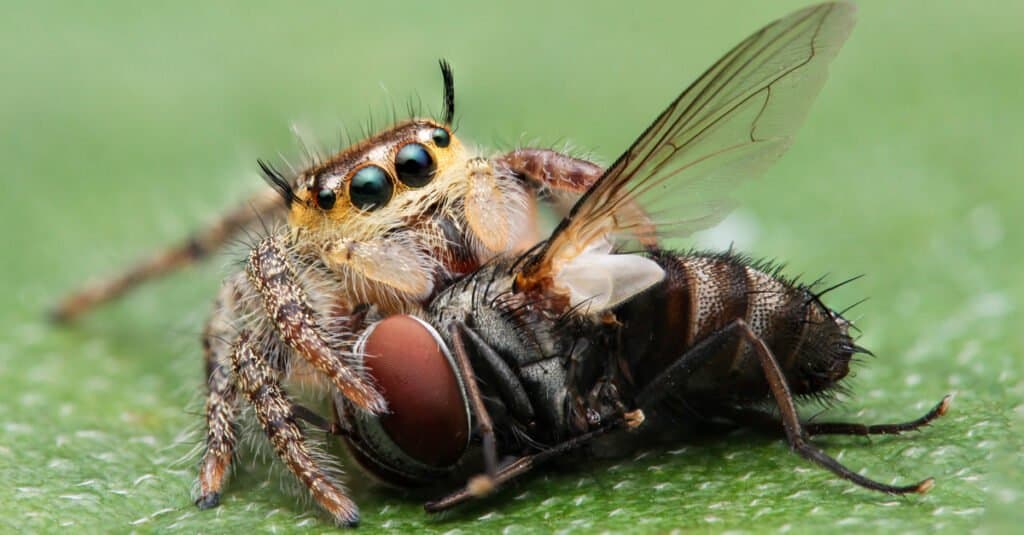
Flies are food for many species including spiders, fish, amphibians, lizards, and birds.
©amirhamzaa/Shutterstock.com
As well as eating up rotting carcasses and excrement, flies pollinate plants and the parasitic species reduce the number of crop-eating caterpillars.
The largest family of parasitic flies are the tachinids. They lay eggs on pests which hatch into larvae and eat the host. It sounds like a horror story, but it reduces the need for chemicals that kill pollinators.
Flies are also a food source for many types of animals such as spiders, frogs, birds, reptiles, and even fish!
What Would Happen If Flies Went Extinct?
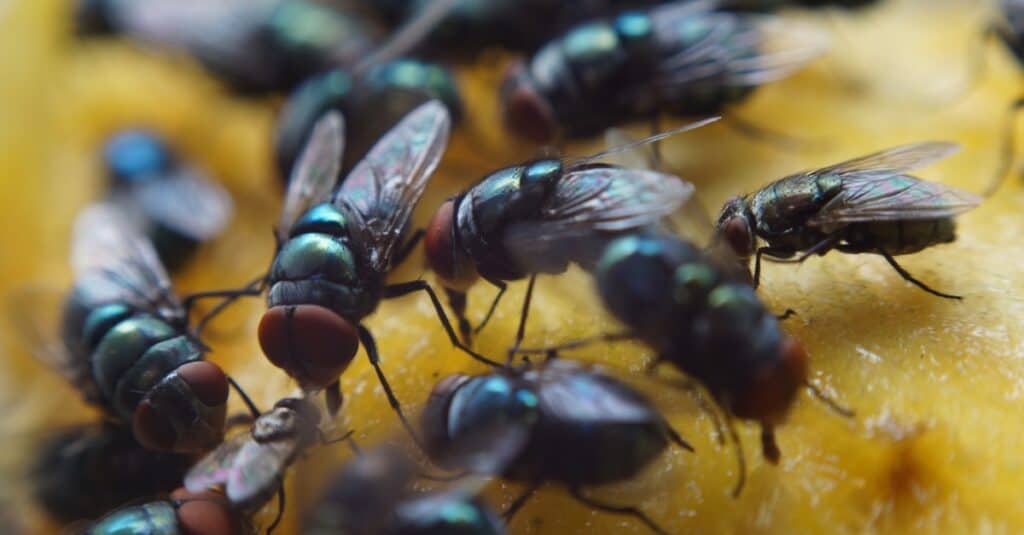
If flies went extinct the planet would fill up with excrement and rotting flesh.
©iStock.com/reyborfrla
If flies went extinct the world would fill up with rotting organic rubbish. It’s because flies are composters. They act as scavengers alongside isopods eating and laying eggs on dead animals, excrement, dead wood, and anything rotting. They’re also excellent pollinators, coming second only to bees.
We may not like them landing on our food or buzzing around the house, but flies are very important and we need them. If they disappeared we’d drown under a tsunami of rotting carcasses and filth. It’s a real shame that flies can’t deal with plastic waste in the same way.
Over time, bacteria and other insects that decompose organic matter would likely evolve and increase in population to fill their space, but this would take time.
What Would Be Some Benefits of No Flies?
While flies are tremendous decomposers, they come with some notable downsides (which is probably why you’re wondering if the world could survive without them!).
- Flies deal tens of billions in economic damage, especially to industries like agriculture as they damage not only plants but also livestock.
- Flies spread disease (more on this below).
- They’re also responsible for painful bites and other annoyances.
Do Flies Spread Disease?
Yes, flies spread a wide range of diseases. It’s because their habit of landing on excrement and rotting things means bacteria clings to their feet. When they land on us or our food they can spread salmonella, E.coli, diarrhea, and create infections.
A fly doesn’t have to land on your skin or food to spread disease, they can spread them through surfaces, cooking utensils – anything you touch.
What About Mosquitoes? Is a Mosquito A Fly?
A mosquito is not a fly, but mosquitoes belong to the same diptera family. The main difference is the way they eat.
Houseflies taste their potential food with their legs. They vomit digestive juice on top and suck up the liquid through a spongy mouth tube. Mosquitoes use a needle-like proboscis to penetrate skin and suck out liquids such as blood. They also eat ‘live’ foods whereas flies eat dead and decaying organic matter.
Why Is It So Hard To Catch A Fly?
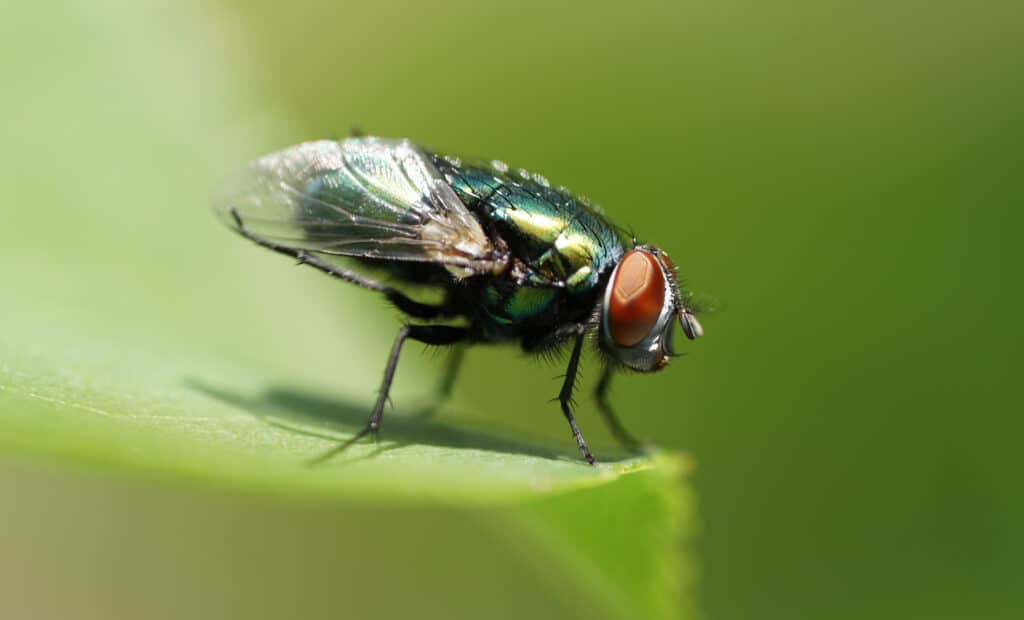
Flies can walk upside down because they have sticky feet.
©Moni.ka/Shutterstock.com
If you’ve ever spent an eternity chasing a fly from your home, you’ll understand this question only too well!
Flies are hard to catch because they have 360-degree vision. They don’t need to move their eyes to see everything because they are spherical. This ‘see-everything’ ability coupled with their secondary wings that allow complete changes of direction in mid-air means they are hard to catch.
But that’s not all. Flies process images faster than we do. It’s called the ‘flicker fusion rate’ and smaller species usually have faster processors. Experts have discovered that some fly species see movement six times faster than us. The fastest processor belongs to Coenosia the ‘killer fly’. This European fly is so quick it catches other flies in midair. An article from research journal PNAS explains just how they do it.
What Do You Call A Fly Without Wings?
A walk.
So now we know that flies spread disease and they are intensely annoying.
But we should also recognize that the world would struggle to cope without their unparalleled clean-up abilities, pollination skills, and parasite removal job. Every species has a part to play in the ecosystem even if we don’t like them much.
The photo featured at the top of this post is © Cherdchai Chaivimol/Shutterstock.com
FAQs (Frequently Asked Questions)
Is It OK To Eat Food A Fly Has Landed On?
There’s no question that flies are unclean. They land on filth and spread it around, but a single touch on your food (or your skin) isn’t an emergency. You can still eat the food and there’s no need to antibac your skin. However, if the food has been left unattended so flies had time to eat and lay eggs (if you look closely, you might spot the tiny white eggs) that’s a sign to throw it away. The same goes for your pet’s food.
It’s a good idea to put food in a fly-safe place such as a refrigerator or cupboard if you are not eating it right away.
Is A Dragonfly A Fly?
No. A dragonfly is not a fly. It’s an insect in the Odonata family. They have two wings, six legs, a head, thorax, and abdomen. Dragonflies are beautiful, ferocious predators and will eat most species of Diptera fly.
How Does A Fly Walk Upside Down?
A fly can walk upside because it has sticky pads on its feet!
Their foot pads have tiny hairs called pulvilli. Pulvilli excretes a sticky liquid that provides grip, but it isn’t strong enough to glue the fly down. Flies can walk on almost anything thanks to their sticky feet.
Thank you for reading! Have some feedback for us? Contact the AZ Animals editorial team.



